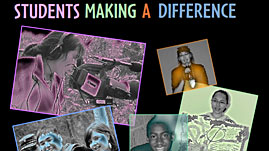Teachers' Domain - Digital Media for the Classroom and Professional Development
User: Preview

Source: Agrium, Inc.; Alaska Youth for Environmental Action; and Homestead Elementary School, Eagle River, Alaska
This interactive activity features three videos that promote better care for the environment, including the Kenai Peninsula in Alaska. One video showcases student projects that raise awareness about household hazardous waste and improve salmon habitat using recycled tires. The other two videos were produced by students in Alaska and focus on a campaign to promote responsible use and disposal of discarded diapers, plastic bags, and other products; and an Athabascan legend that illuminates the importance of caring for natural resources. The videos are adapted from Agrium, Inc.; Alaska Youth for Environmental Action; and Homestead Elementary School, Eagle River, Alaska.
To address the glaring need for protecting the environment in Alaska and elsewhere in the U.S., individuals of all ages and backgrounds have pursued innovative ideas for conservation, reuse, and recycling. In many cases, generating awareness that a problem exists is the most important thing someone can do to inspire meaningful change. The videos presented in this resource provide examples of students taking action to help solve an environmental problem or to raise awareness of the importance of preserving healthy ecosystems.
In "Kids Care for the Kenai" (Video 1), Megan describes her board game, which introduces young students to the problems that common hazardous household chemicals and debris can cause to ecosystems when they are improperly disposed of. In the second half of the video, Ryan proposes a solution to care for the threatened salmon habitat along Southcentral Alaska's Kenai River. Boat wakes and urban development have destroyed some of the undercut banks, which control the flow of water and provide fish with protection from the river's currents and predators. Fishermen have also helped accelerate streamside erosion as they walk into and out of rivers. By creating an artificial habitat made from used tires, a waste material that is otherwise hard to dispose of, the student took action to improve the quality of life for both community members and wildlife.
Spencer's diaper and the other examples featured in "Recycle Our Waste" (Video 2) illuminate how long common waste products remain in the environment. The students who produced this video suggest a time horizon for how long it takes plastic bags, styrofoam cups, and soda cans to degrade. This helps others grasp the detrimental environmental impact that people's choices can have.
"The Girl Who Swam with the Fish" (Video 3) teaches the importance of respecting natural resources—in this case, salmon—in order to preserve the conditions that will sustain them. This Athabascan legend also highlights the intimate relationship Alaska Native cultures share with nature.
 Loading Standards
Loading Standards Teachers' Domain is proud to be a Pathways portal to the National Science Digital Library.
Teachers' Domain is proud to be a Pathways portal to the National Science Digital Library.
